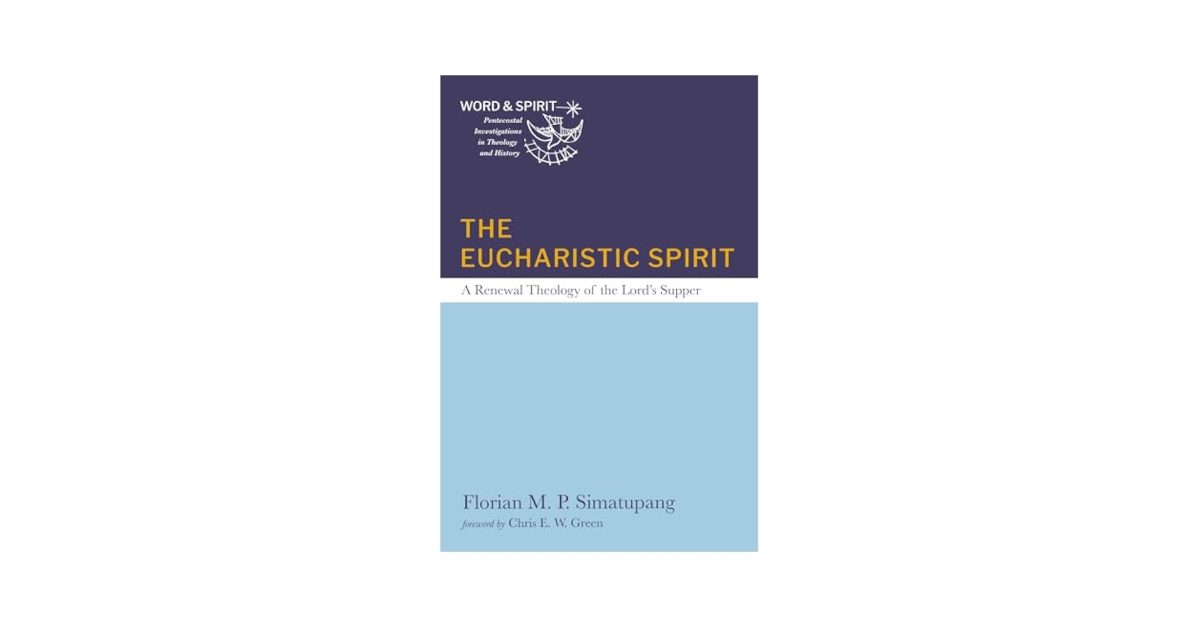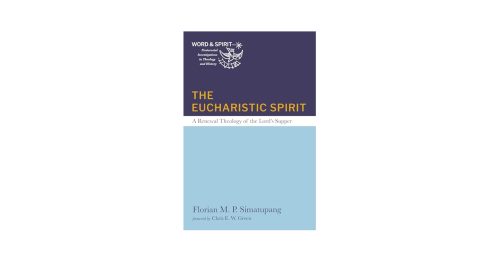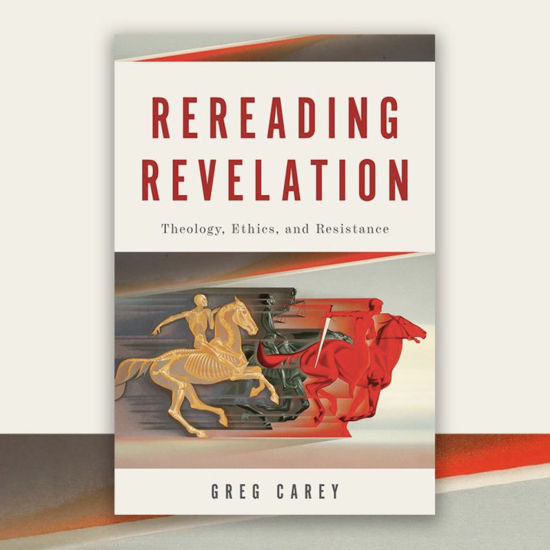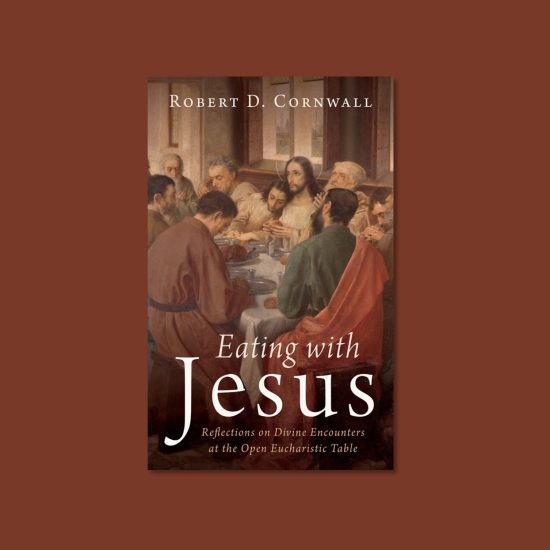

THE EUCHARISTIC SPIRIT: A Renewal Theology of the Lord’s Supper (Word & Spirit). By Florian M. P. Simatupang. Foreword by Chris E. W. Green. Eugene, OR: Cascade Books, 2025. Xiii + 213 pages.
During my sojourn in Pentecostalism, the Lord’s Supper rarely played a significant role in our worship gatherings. When we did have communion, the presentation of the sacrament (ordinance) did not draw specifically from Pentecostal theology. As I remember, communion was understood as a memorialistic event. We were told that the reason we didn’t observe this ordinance very often is that if celebrated too often, it would become devoid of meaning. It’s the same message I heard in other evangelical settings where communion was a rarity. Might it be wise for Pentecostals to rethink their eucharistic theologies and practices? Could the idea that frequent communion would make it less meaningful be incorrect? Being that I am an ordained minister in a tradition that practices weekly communion, I would disagree with that assessment, but what about Pentecostals? Might they benefit from embracing a more robust eucharistic theology and practice, one that is rooted in Pentecostal theology rather than evangelicalism?

Robert D. Cornwall
One who wishes to embrace a robust eucharistic theology and practice that includes frequent communion is Florian M. P. Simatupang. His book The Eucharistic Spirit is a revision of his doctoral dissertation, which is subtitled A Renewal Theology of the Lord’s Supper. In this book, Simatupang, who is an assistant professor of theology at Jakarta Theological Seminary, seeks to develop a distinctly Pentecostal theology of the Lord’s Supper. What makes Simatupang’s book even more valuable is that it emerges out of his background as an Indonesian Christian, such that his theology emerges out of a highly pluralistic context.
The question that Simatupang seeks to answer concerns the question of what “sort of experience of grace does the Holy Spirit give a Pentecostal believer when one celebrates the Eucharist?” To answer this question, he uses a process rooted in Pentecostal spirituality known as “Search-Encounter-Transformation” (SET). This is a methodology I was unfamiliar with, such that I had to go back several times to find the definition. Nonetheless, it provides Simatupang with a helpful interpretative grid to explore his subject. In working through various Pentecostal theologies of the Eucharist, he often turned to comparisons with other traditions, including Eastern Orthodoxy and Roman Catholicism, as a lens, especially when it comes to the concept of anamnesis, which he believes broadens the Pentecostal understanding of salvation. Thus, “As the Holy Spirit is called upon in the epiclesis, he allows the church to attain a pneumatological imagination, enabling the church to remember the work of Christ well.” Using the SET process, he engages with biblical texts and other Christian traditions to create a renewal theology of the Eucharist. Simatupang’s goal in this effort is to highlight an experience of transformation that takes place in the context of the Eucharist.
There are elements here of a typical dissertation. In the early chapters, the author reviews traditional Pentecostal understandings of the Eucharist, focusing on official documents/theological statements on the part of the Assemblies of God, Church of God (Cleveland, Tennessee), and the International Church of the Foursquare Gospel. Besides these statements, which are brief and not very informative, he also examines non-official but fuller statements on the Eucharist provided by leading Pentecostal theologians, including Chris Green, Wolfgang Vondey, and Amos Yong, among others. These provide the foundation for the further exploration of biblical texts and perspectives from outside Pentecostalism that he believes might enrich Pentecostal sacramental understandings. Therefore, the introduction and the first two chapters of the book offer an analysis of Pentecostal Eucharistic theology along with Ecumenical Eucharistic Theology. Then in chapter 4, Simatupang offers a “Rereading” of the “Biblical Text.” In this chapter, he reviews each of the relevant passages in the New Testament, offering a helpful summary of this teaching on the central work of the Church.
Once Simatupang lays down the foundations of his sacramental theology, he moves on to the material that I found the most interesting in the book. It is Chapter 5, where he lays out “A Renewal Theology of the Eucharist,” in which Simatupang begins to provide his vision of a Pentecostal renewal theology of the Eucharist. What I found fascinating here is the author’s discovery of important words of wisdom in both the Orthodox and Catholic worlds. This includes his attempts to rethink the Catholic doctrine of transfiguration in a pneumatological manner, such that he can envision the recipients of the Eucharist being transformed. He makes seven points in this chapter concerning the Eucharist from a Pentecostal perspective that I believe could easily be turned into a book of its own.
The first point concerns the “Eucharist as Solidarity.” By that, he envisions the Eucharist serving as a point of solidarity with Christ and with others. Secondly, he speaks of the “Eucharist as Justice.” He speaks directly here of the problem of white privilege in the church. Third, he speaks of the “Eucharist as Hunger Management.” He calls for the church to envision the need to feed the hungry as an outgrowth of the Eucharist. This call to feed others is rooted in the Pentecostal communities’ “search and encounter Christ at the table and is fed by the Lord at his table, they are given a foretaste of the uninterrupted eschatological feast of the Kingdom of God. In this eschatological feast, no one goes hungry because all will be fed by the Lord himself, who dwells among his people.” This should lead to engaging in feeding those who are hungry (p. 157). The fourth point envisions the “Eucharist as healing.” The Pentecostal movement has a long tradition of healing ministry. Here, the author connects this tradition with the Eucharist as a healing event. It is here that he brings in the Catholic doctrine of transubstantiation, but with a twist, such that it speaks to the embodiedness of the faith.
Fifth, he speaks of “Eucharist as Mission.” This is another key Pentecostal element as the movement has, from the beginning, had a missionary impulse. He lists three ways in which it is missional—in its discernment in seeing the other, in sending Christians into the world, and finally as a sign of the eschatological feast. Regarding this last element, he writes of the “Eucharist as Eschatology.” Here, he wishes to steer Pentecostals in a different eschatological direction than the typical millenarian vision, such that he draws on Eastern Orthodox theology to envision a “now, not yet” view that leads to Christian unity. He believes embracing the Eucharist can help clarify Pentecostal eschatology. This eschatological vision offers a theological foundation to the Pentecostal vision of an open table as a “forecast of the eschatological righteousness, peace, and joy that will be made complete by the Holy Spirit” (p. 173). The seventh dimension is “Eucharist as Apokatastasis,” or the restoration of all things. In his view, the Eucharist involves transformation and restoration. As such, there is nothing transformative about either annihilation or eternal damnation. That might not sound like typical Pentecostal theology, but it is a way of connecting Pentecostal understandings of the role of the Holy Spirit with input from other Christian traditions, especially Eastern Orthodoxy. I found this section fascinating.
Having recently published a book on the Eucharist myself with the same publisher — Eating with Jesus: Reflections on Divine Encounters at the Open Eucharistic Table — I found several places in this final chapter where he lays out his eucharistic vision, where the two of us come to similar positions. This includes his emphasis on the open table and the table being a place of encounter with Jesus that is facilitated by the Holy Spirit. While we may have come at describing the role of the eucharistic table from different vantage points, they do connect in intriguing ways.
Chapter 6 functions as a conclusion to The Eucharistic Spirit, drawing together in a nice summation what he had offered in the preceding chapters. As for implications for Pentecostalism, he offers this book as a foundation of an argument for frequent (weekly at least) communion. If this renewal theology is followed, he believes it will lead to a paradigm shift, such that it will become more than a commemorative event, and will allow Pentecostals to see Christ feeding himself to us so we become what we eat.
Florian Simatupang’s The Eucharistic Spirit offers Pentecostals and others a way of re-envisioning the Eucharist, making it a more central part of the life of the Church. It will be interesting to see how this book is received in Pentecostal circles, especially since the Eucharist is not generally a central component of Pentecostal theology or practice. I would love to see him flesh out the material in chapter 5 because it might offer an ecumenical, eschatological, and pneumatological vision of the Lord’s Supper not only to Pentecostals, who are the target audience of the book, but the larger church, which would benefit from the message he offers here.
This review originally appeared on BobCornwall.com.
Robert D. Cornwall is an ordained minister in the Christian Church (Disciples of Christ). Now retired from his ministry at Central Woodward Christian Church (Disciples of Christ) of Troy, Michigan, he serves as Minister-at-Large in Troy. He holds a Ph.D. in Historical Theology from Fuller Theological Seminary and is the author of numerous books, including his latest “Second Thoughts about the Second Coming: Understanding the End Times, Our Future, and Christian Hope” coauthored with Ronald J. Allen. His blog Ponderings on a Faith Journey can be found here.






